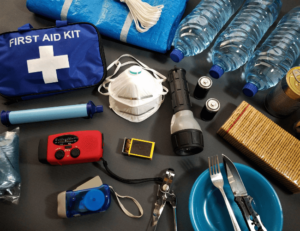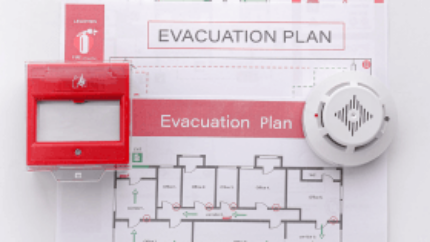Are you ready for anything life throws your way? From minor cuts and scrapes to major emergencies, having a first aid survival kit on hand could mean the difference between life and death.
In this article, we’ll explore the essential items you need in your kit, as well as some unexpected uses for common supplies.
Whether you’re a seasoned prepper or just starting out on your survival journey, this guide will ensure you’re prepared for any situation that comes your way.
Gathering Your Medical Supplies
 Oddly enough, when planning for a survival event, many people forget all about the medical supplies they may need. They’re hyper focused on food, water and shelter, but in case you or a loved one were injured, even slightly, it could spell disaster without the right supplies.
Oddly enough, when planning for a survival event, many people forget all about the medical supplies they may need. They’re hyper focused on food, water and shelter, but in case you or a loved one were injured, even slightly, it could spell disaster without the right supplies.
You need more than what you already have in your cabinets. Most households have some medicine for headaches, Band-Aids and maybe something for an upset stomach or heartburn.
But you may need more – like supplies to create a splint for a strain or a tourniquet. If there is anyone in your family on prescription medication, you’ll need backup supplies for that, or even holistic supplements in case you’re unable to get prescriptions any longer.
You need to be strategic with how you store them, too. Any water damage could ruin bandages and gauze or tape. Think about the fact that you may not have access to a doctor, hospital or pharmacy and prepare based on what you can do yourself.
Buying a Starter First Aid Survival Kit
In the beginning of your survival prepper journey, you can start with supplies that have readymade kits. These are good starting points for any beginner and they’re convenient, too.
The problem is they’re not really meant for survival situations. They’re meant for everyday injuries at home or while camping out or hiking – when you could easily use a short-term solution and visit the doctor or hospital for anything more serious.
With a starter kit, you’ll find some very basic ones and some larger ones, too. A basic one is made for something as minor as cuts and scrapes. It might include antiseptic towelettes, alcohol prep pads, a cold compress, antibiotic ointment, and a variety of bandages and gauze pads, gloves, splints and a small first aid guide.
You can find first aid kits that have much more than the smaller ones, or ones with additional perks. For example, you can buy ones with over 400 pieces of first aid supplies – or ones that have waterproof cases.
There are also miniature first aid kits that even include a survival foil blanket for times when you might be bugging out and end up in need of some emergency supplies to get you through the night.
Adding to a Readymade First Aid Survival Kit
 When you buy your first aid kit in the beginning, make a list of what it includes. Don’t just write “bandages,” though. Write down the size and amount that are included. Then make a list of what all you want to have on hand in your first aid survival kit.
When you buy your first aid kit in the beginning, make a list of what it includes. Don’t just write “bandages,” though. Write down the size and amount that are included. Then make a list of what all you want to have on hand in your first aid survival kit.
If your first aid survival kit doesn’t include any aspirin or medical tape, you can start a list of things to buy. Or, if it has four bandages, you don’t have to re-purchase a whole new kit, but just buy the items within it that you want more stock of, like gauze or medical tape.
You may have other tools you want to get for survival first aid supplies. These may include things like a tourniquet or a skin stapler, so more extreme survival injuries that need addressing.
First aid usually reflects an injury, but it can be something where you’re tending to on-going medical needs, too. When you’re in a survival situation, you may not be able to call the doctor up and get a prescription, so you’ll want things to help stave off illnesses, like Vitamin C supplements and multivitamins.
It’s important for you to consider what may happen in a survival event that could spiral out of control fast. For example, an allergic reaction without having antihistamines on hand could be dangerous.
Or a simple issue of diarrhea could cause severe dehydration, so you would need medication to treat this issue. Nausea might be an issue, depending on the person and situation, so your going to want items to treat that as well.
Some people prefer to use liquid bandages over normal gauze-type bandages because they’re more durable and convenient than a Band-Aid type bandage. This also works well on pets, too.
Personalize First Aid Supplies for Your Family
Not only do you want to have an abundance or ordinary supplies on hand for first aid purposes, but you also want to personalize your supplies to match the needs of everyone in your family.
Even something as simple as having antacids in storage for a loved one who suffers from heartburn will be a welcomed purchase. You can put them in the main supplies, or you can make kits for each person that they can add to their bug out bag.
When planning for personalized first aid supplies, think about each person’s medical needs – whether they’re diabetic, elderly, children, etc. This will require you to invest in a variety of first aid products.
Electrolytes used to rehydrate children can be different from those used on adults. You might even need to think about what your pets could need for first aid.
Must Have Medicines
Organizing and Protecting First Aid Supplies
Make sure you keep all of your supplies safe and organized. Safety means the items contained within aren’t contaminated. For example, you don’t want your first aid kit floating in stagnant water during a flood because it wasn’t properly sealed or put in a dry location.
But you also have to maintain safety in other ways. Each item should be carefully labeled. You should be able to read the dosage and expiration dates. Maintain an inventory of what you have if at all possible.
Rotate any goods with an expiration date, such as ibuprofen, to avoid stockpiling old prescriptions. You should also print and laminate any medical records and vital health information to keep with your first aid equipment.
Plan for Long-Term In Case Supplies Run Out
 If you ever find yourself in a long-term survival situation, you may run out of supplies. So plan for that day even if it never happens. Herbal remedies could become useful and help with everything from nausea to headaches.
If you ever find yourself in a long-term survival situation, you may run out of supplies. So plan for that day even if it never happens. Herbal remedies could become useful and help with everything from nausea to headaches.
You can use certain leaves for antiseptics or to help with burns, too. If you have someone in your family who wears contacts or has dry eyes, you can learn how to create a saline solution from salt and water.
Consider dental health as well. This is something that can be extremely painful, and they have emergency dental pain kits you can use that will provide relief until you can take care of the problem.
When preparing your first aid survival kit, don’t only consider physical health. Mental health is also vital, so having items on hand for mood enhancement or stress relief will become just as necessary.
First aid survival preparations are more than just purchasing products. You’ll also want to devote time to learning how to use them. Not just for you, but also for your loved ones.
Get everyone involved because they may become separated from the group and need to treat themselves medically, or you could become injured and they’ll have to look after you. Even smaller kids need to know how to administer basic first aid as soon as they are ready. All of these elements should be considered when it comes to survival first aid.
Conclusion: Be Prepared for Any Emergency
Preparing a first aid survival kit is a crucial step in ensuring your readiness for emergencies. By having essential supplies on hand and knowing how to use them effectively, you can provide immediate care and potentially save lives.
Remember to regularly check and restock your kit, keeping it easily accessible in case of an emergency. Taking the time to prepare now can make all the difference when faced with a crisis situation.
So don’t delay, start assembling your first aid survival kit today and be prepared for whatever comes your way!


